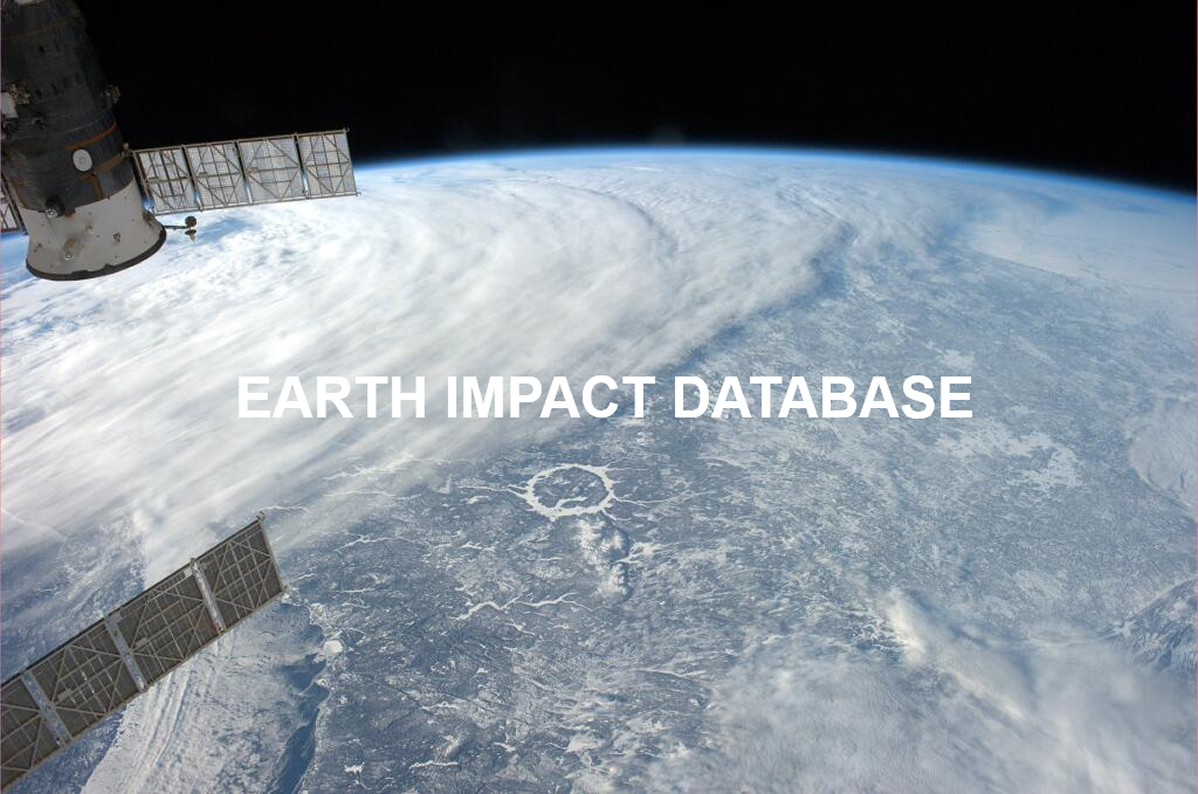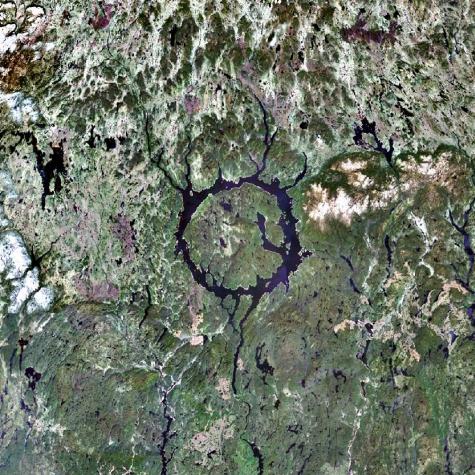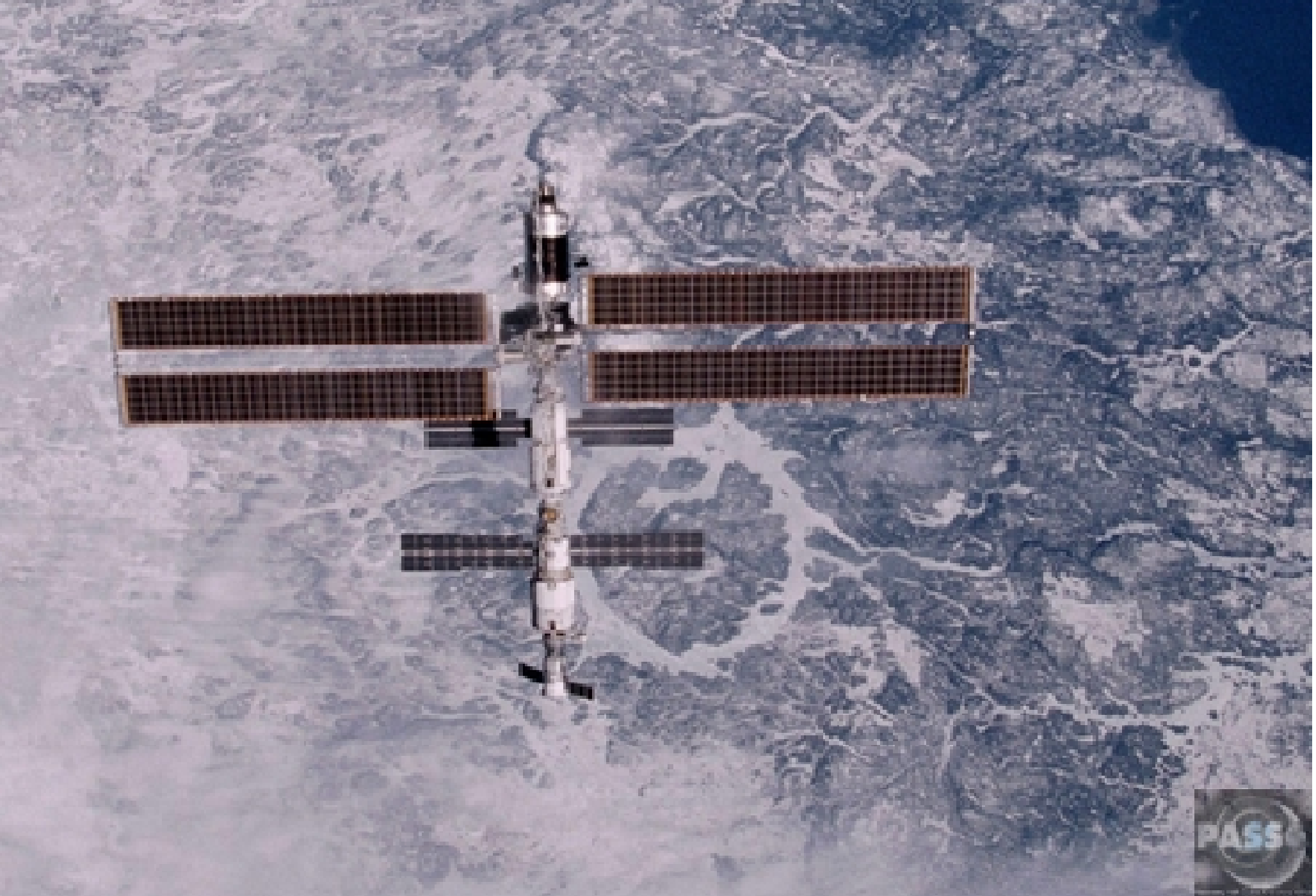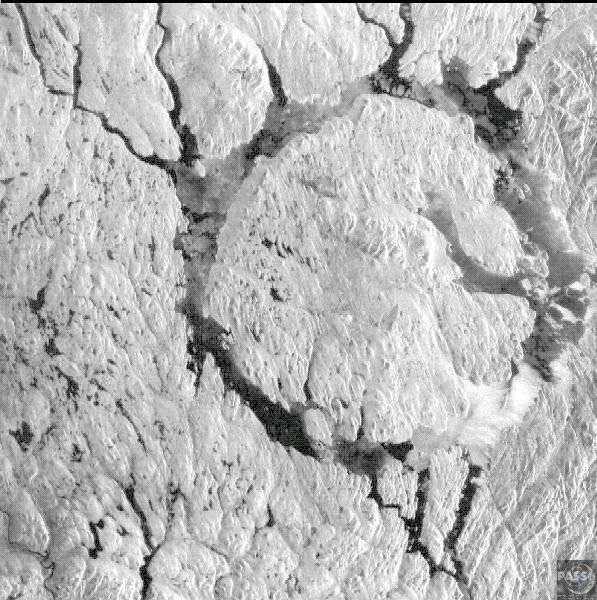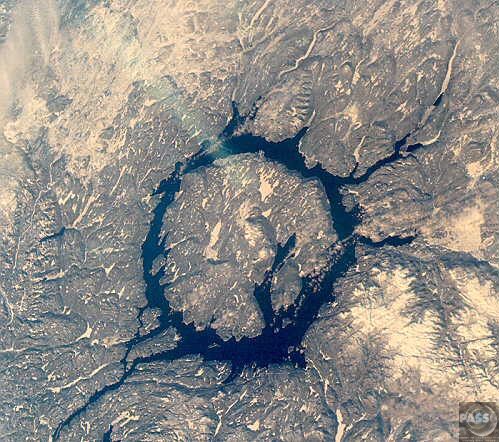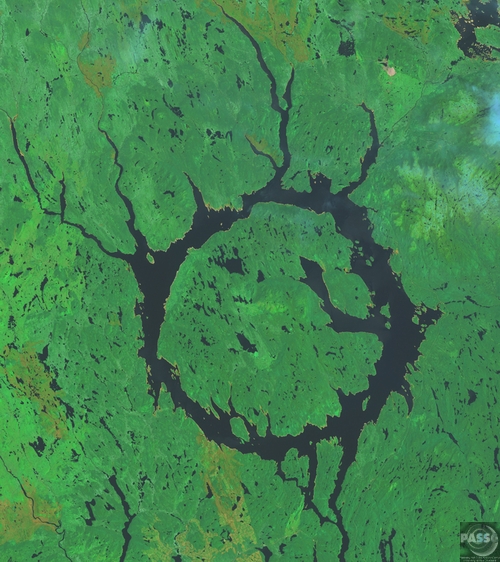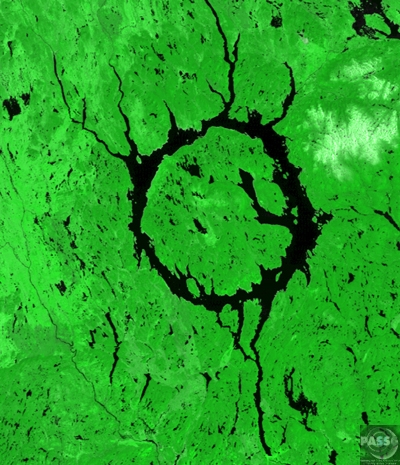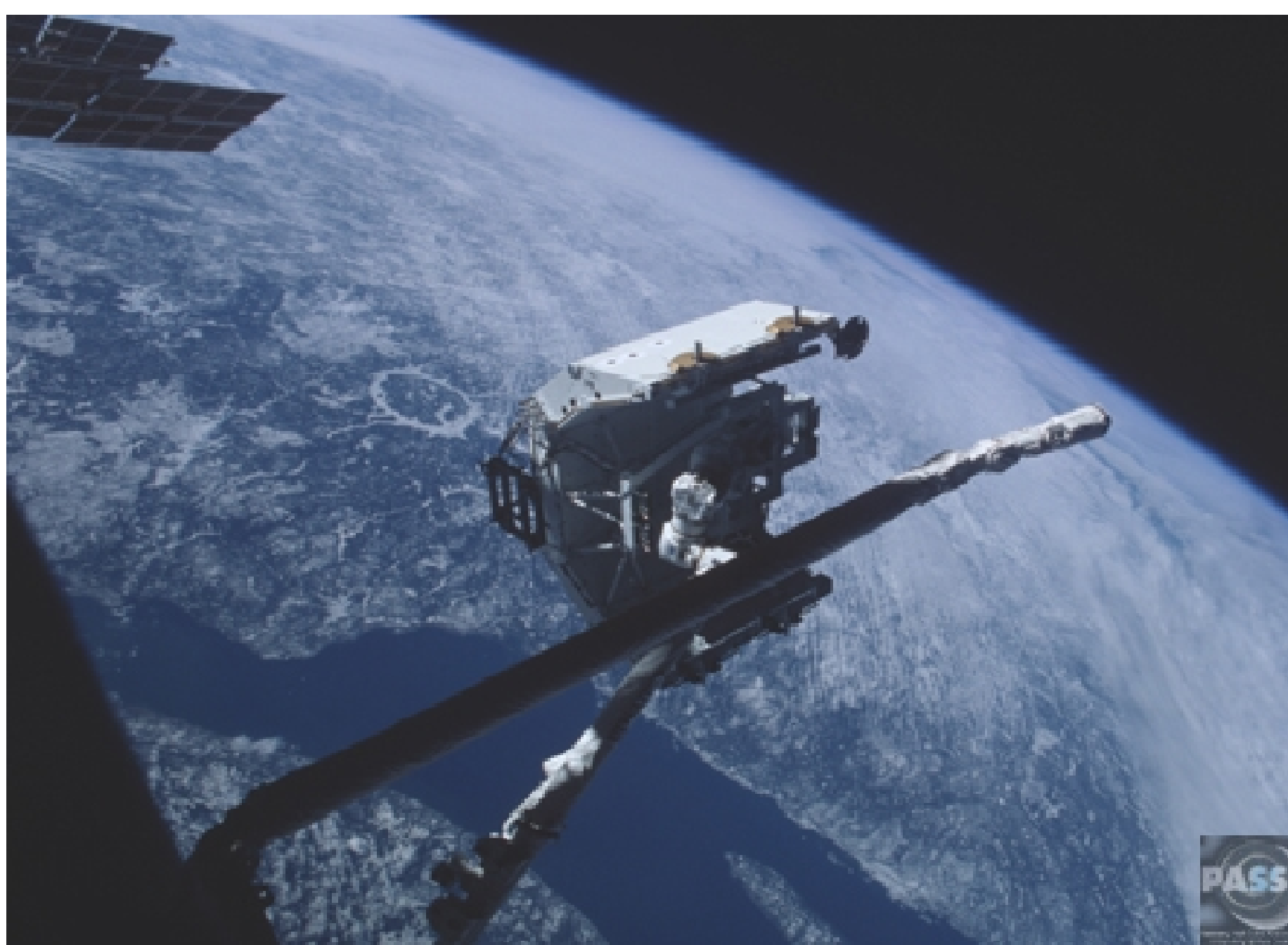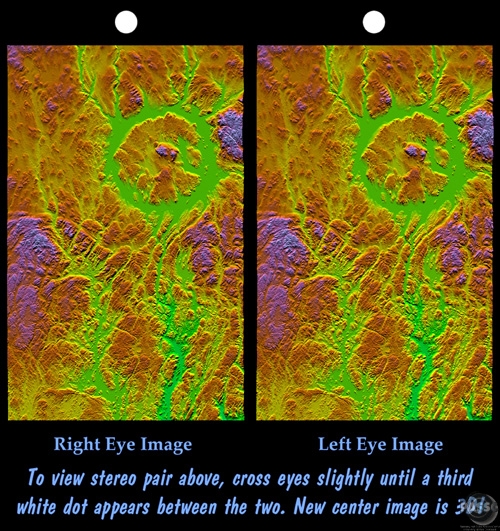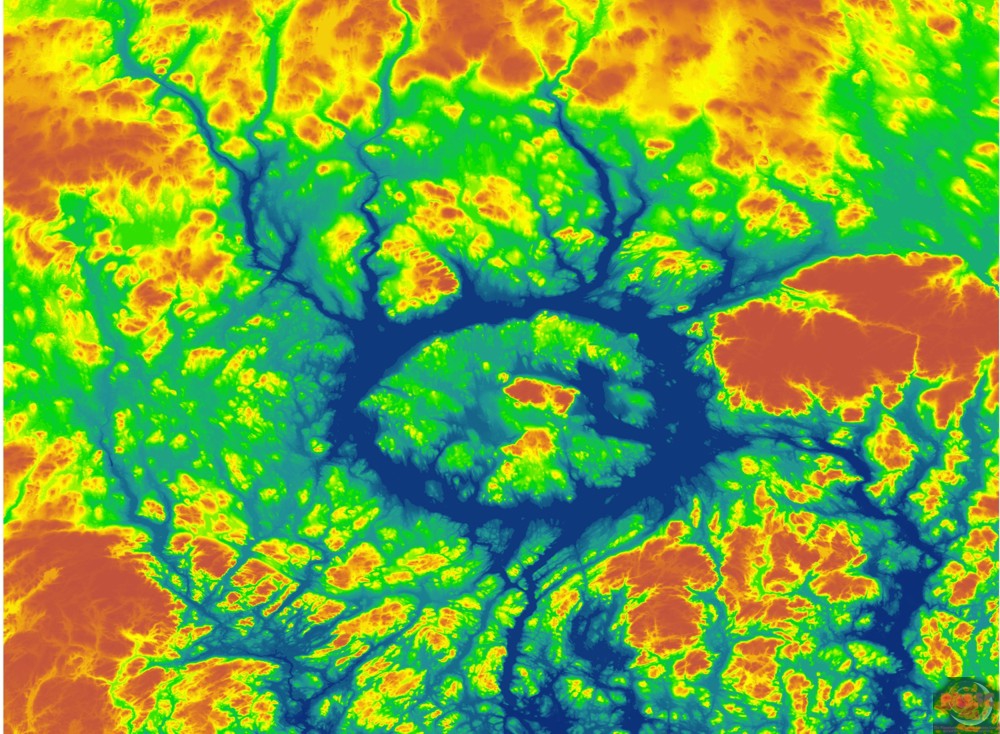Manicouagan
| Crater Name | Location | Latitude | Longitude | Diameter (km) | Age (Ma) | Exposed | Drilled | Target Rock** | Bolide Type*** |
|---|---|---|---|---|---|---|---|---|---|
| Manicouagan | Quebec, Canada | N 51° 23' | W 68° 42' | 85 | 214 ± 1 | Y | Y | M | - |
1. Landsat 7 image (Bands 1,2,3) of the Manicouagan impact structure, Canada. Width of image: 250 km. Compiled by Mary-Anne Fobert, Planetary and Space Science Centre, UNB.
2. Shuttle Image STS-100 332-011 with International Space Station April, 2001 - submitted by Chuck Simonds
3 & 4. Shuttle
5. Landsat 7 Image, bands 742 provided by Ronald W. Hayes, USGS
6. MODIS R: band 1 (620-670nm), G: band 2 (841-876nm), B: band 1 Submitted by Judd Taylo
7. Shuttle image: View of the "handshake" / passing of the Spacelab Pallet (SLP) between Endeavour's Remote Manipulator System (RMS) and the newly installed Space Station Remote Manipulator System (SSRMS)/Canadarm2 during the STS-100 mission. Manicouagan crater, Quebec, Canada is visible in the background. Submitted by Chuck Simmonds
8. Shuttle Radar Topography Mission (SRTM) C-Band Interferometric Radar Stereo Pair, with Topographic Height as Colour
9. DEM
References |
Ambrose, J. W. 1964. Exhumed paleoplains of the Precambrian shield of North America. American Journal of Science, 262, 817–857. |
Arndt, J., and Gonzalez-Cabeza, I. 1980. The viscous flow behavior of diaplectic glass and fusion-formed glass: A Comparitive study on shocked anorthosite from Manicouagan crater, Canada. 11th Lunar and Planetary Science Conference, abstract #1012. |
Arndt, J., and Gonzalez-Cabeza, I. 1981. Diaplectic glass and fusion-formed glass: Comparative studies on shocked anorthosite from Manicouagan crater, Canada. 12th Lunar and Planetary Science Conference, abstract #1011. |
Arndt, J., Hummel, W., and Gonzalez-Cabeza, I. 1982. Diaplectic labradorite glass from the Manicouagan impact crater. 1. Physical properties, crystallization, structural and genetic implications. Physics and Chemistry of Minerals, 8, 230–239. |
Basilevsky, A. T., Fel’dman, V. I., Kapustkina, I. G., and Kolesov, G. M. 1984. On the distribution of iridium in the rocks of terrestrial impact craters (in Russian). Geokhimiya, 6, 781–790. |
Basilevsky, A. T., Florenskiy, K. P., Yakovlev, O. I., Ivanov, B. A., Fel’dman, V. I., and Granovskiy, I. B. 1982. Transformation of planetary material in high-speed collisions (in Russian). Geokhimiya, 7, 946–960. |
Beals, C. S. 1967. Terrestrial meteorite craters and their lunar counterparts. Ottawa Dominion Observatory Contributions, 7, 1–10. |
Beals, C. S., Innes, M. J. S., and Rottenberg, J. A. 1960. Fossil meteorite craters. In B. M. Middlehurst & G. P. Kuiper (Eds.), The Moon, Meteorites and Comets (p. 235–284). University of Chicago Press, Chicago. |
Bérard, J. 1962. Summary geological investigation in the area bordering Manicouagan and Mouchalagane Lakes, Saguenay County, Quebec. Department of National Resources, 489, 1–14. |
Biren, M. B. 2012. The central uplift of the Manicouagan impact structure, Ph.D. Thesis. Planetary and Space Science Centre, Department of Earth Sciences, University of New Brunswick, Canada, 386 p. |
Biren, M. B., and Spray, J. G. 2011. Shock veins in the central uplift of the Manicouagan impact structure: Context and genesis, Quebec, Canada. Earth and Planetary Science Letters, 303, 310–322. |
Biren, M. B., Spray, J. G., and Thompson, L. M. 2008. The anorthositic central uplift of the Manicouagan impact structure. Geological Society of America Abstracts with Programs, 40(6), 239. |
Biren, M. B., van Soest, M., Wartho, J.-A., and Spray, J. G. 2014. Dating the cooling of exhumed central uplifts of impact structures by the (U-Th)/He method: A case study at Manicouagan. Chemical Geology, 377, 56–71. |
Boivin, L and Minéraux Manic Inc. 1997. Summary of work in Manicouagan impact structure. Large Meteorite Impacts and Planetary Evolution, abstract #6107. |
Borning, J., Floran, R. J., and Simonds, C. H. 1975. Rb-Sr Isochron Age of the Manicouagan impact melt sheet, Quebec, Canada. Unpublished Report. |
Bridges, L. W. D. 1997. Ames depression, Oklahoma: Domal collapse and later subsurface solution. Ames Structure in Northwest Oklahoma and Similar Features: Origin and Petroleum Production (1995 Symposium). Oklahoma Geological Survey, Norman, Oklahoma, 100, 153–168. |
Budkewitsch, P., and Grieve, R. 1997. Synthetic aperture radar characteristics of a glacially modified meltsheet, Manicouagan, Quebec. In International Conference on Large Meteorite Impacts and Planetary Evolution (Sudbury 1997). LPI Contribution, 922, 6. |
Bunch, T. E., and A.J. Cohen. 1967. Natural terrestrial maskelynite. American Mineralogist, 52, 244–253. |
Cirilli, S. 1995. Evidence for a climate change at the Norian-Rhaetian boundary (late Triassic): Is the Manicouagan the culprit? (abstract). 4th International Workshop of the ESF Scientific Network on “Impact Cratering and Evolution of Planet Earth”. The Role of Impacts on the Evolution of the Atmosphere and Biosphere with Regard to Short- and Long-Term Changes, 54. |
Clark, J. F. 1983. Magnetic survey data at meteoritic impact sites in North America. Geomagnetic Service of Canada. Earth Physics Branch Open File # 83-5, 30. |
Cockell, C. S., and Lee, P. 2002. The Biology of Impact Craters - a review. Biological Reviews, 77, 279–310. |
Coles, R. L., and Clark, J. F. 1978. The central magnetic anomaly, Manicouagan structure, Quebec. Journal of Geophysical Research, 83, 2805–2808. |
Cox, R. A., Indares, A., and Dunning, G. R. 2002. Temperature-time paths in the high-P Manicouagan imbricate zone, eastern Grenville Province: evidence for two metamorphic events. Precambrian Research, 117, 225–250. |
Currie, K. L. 1964. On the origin of some “recent” craters on the Canadian shield. Meteoritics & Planetary Science, 2, 93–110. |
Currie, K. L. 1972. Geology and petrology of the Manicouagan resurgent caldera, Quebec. Canada Geological Survey Bulletin 198, 153. |
Currie, K. L., and Shafiquallah, M. 1968. Geochemistry of some large Canadian craters. Nature, 218, 457–459. |
Dabizha, A. I., and Fedynsky, V. V. 1975. The Earth’s “star wounds” and their diagnosis by geophysical methods (in Russian). Zemlya I Vselennaya, 3, 56–64. |
Dence, M. R. 1964. A comparative structural and petrographic study of probable Canadian meteorite craters. Meteoritics & Planetary Science, 2, 249–270. |
Dence, M. R. 1971. Impact melts. Journal of Geophysical Research, 76, 5552–5565. |
Dence, M. R. 1972. The nature and significance of terrestrial impact structures. 24th International Geological Congress Proceedings, 15, 77–89. |
Dence, M. R. 1977. The Manicouagan impact structure, Quebec, from Skylab. Skylab Explores the Earth, 380. |
Dence M.R., Grieve R.A.F., Robertson, P.B. Terrestrial impact structures - Principal characteristics and energy considerations, 1977. |
Dence, M. R., The Manicouagan impact structure observed from Skylab. National Aeronautics and Space Administration, 380, 175–189., 1978. |
Dence M.R., Estimates of impact flux from terrestrial crater counts - the role of gravity and target properties, 2006. |
Diemann, E., and Arndt J., X-ray diffraction study of the structure of diaplectic anorthosite glass from Manicouagan impact crater, Canada. 13th Lunar and Planetary Science Conference, abstract #1090, 174–175, 1984. |
Dietz, R. S. 1968. Shatter cones in cryptoexplosion structures. In B. M. French & N. M. Short (Eds.), Shock Metamorphism of Natural Materials (p. 267–285). Baltimore, MD: Mono Book Corp. |
Dressler, B. 1990. Shock metamorphic features and their zoning and orientation in the Precambrian rocks of the Manicouagan structure, Quebec, Canada. Tectonophysics, 171, 229–245. |
Dressler, B. O. 1970. Stress of Precambrian rocks in the crypto-explosion structure of Manicouagan in the province of Quebec, Canada (in German). Ph.D. Thesis. Ludwig Maxmilian University, Department of Natural Sciences, Munich, 99 p. |
Dunning, G., and Indares, A. 2010. New insights on the 1.7-1.0 Ga crustal evolution of the central Grenville Province from the Manicouagan-Baie Comeau transect. Precambrian Research, 180, 204–226. |
Dworak, U. 1969. Shock metamorphism of the anorthosite from Manicouagan crater, Quebec, Canada (in German). Contributions to Mineralogy and Petrology, 24, 306–347. |
Eaton, D. W., and the Manicouagan Corridor Working Group. 1995. Crustal structure in the eastern Grenville Province near the Manicouagan Reservoir, Quebec (abstract). Geological Survey of Canada Forum ’95. |
Fel’dman, V. I. 1995. Rare-Earth elements in astrobleme impactites. Geochemistry International, 32, 24–48. |
Fel’dman, V. I., Sazonova, L. V., and Granovsky, L. B. 1982. A classification of impactites based on petrographic and geological features (in Russian). Ispytateley Prirody Byull., Otdel. Geol, 57, 84–94. |
Fleischer, R. L., Viertl, J. R. M., and Price, P. B. 1969. Age of the Manicouagan and Clearwater Lake craters. Geochimica et Cosmochimica Acta, 33, 523–527. |
Floran, R. J. 1978. Manicouagan impact melt, Quebec, 1, stratigraphy, petrology, and chemistry. Journal of Geophysical Research, 83, 2737–2759. |
Floran, R. J., and Dence, R. J. 1976. Morphology of the Manicouagan ring-structure, Quebec, and some comparisons with lunar basins and craters. In Proceedings of the 7th Lunar Science Conference, 2845–2865. |
Floran, R. J., and Jahn, B. 1976. Petrology and Rb/Sr systematics of the Manicouagan impact melt, Quebec (abstract). American Geophysical Union, 57, 275. |
Floran, R. J., Simonds, C. H., Grieve, R. A. F., Phinney, W. C., Warner, J. L., Rhodes, M. J., Jahn, B.M. and Dence, M. R. 1976. Petrology, structure and origin of the Manicouagan Melt Sheet, Quebec, Canada: A preliminary report. Geophysical Research Letters, 3(2), 49–52. |
Gault D.E., Greeley R., Exploratory experiments of impact craters formed in viscous-fluid targets - analogues for Martian rampart craters, 1978. |
Goltrant, O., Cordier, P., and Doukhan, J.-C. 1991. Planar deformation features in shocked quartz; a transmission electron microscopy investigation. Earth and Planetary Science Letters, 106, 103–115. |
Gray, S. 1979. Un cratere devoile une enigme (in French). GEOS, 16–18. |
Grieve, R. A. F. 1977. Manicouagan: A model for melt and transient cavity development (abstract). EOS, 58, 424. |
Grieve, R. A. F. 1982. The record of impact on Earth: Implications for a major Cretaceous/Tertiary impact event. Geological Society of America, 190, 25–37. |
Grieve, R. A. F., and Floran, R. J. 1978. Manicouagan impact melt: Chemical interrelations with basement and formational process. Journal of Geophysical Research, 83, 2761–2771. |
Grieve, R. A. F., and Head, J. W. 1981. Manicouagan impact structure: Its original dimensions and form (abstract). Meteoritics & Planetary Science, 16, 320–321. |
Grieve, R. A. F., and Head, J. W. 1982. Constraints on the original dimensions and form of the Manicouagan impact structure (abstract). 13th Lunar and Planetary Science Conference, abstract #1146, 283–284. |
Grieve, R. A. F., and Head, J. W. 1983. The Manicouagan impact structure: An analysis of its original dimensions and form. Journal of Geophysical Research, Supplement, 88, 807–818. |
Grieve, R. A. F., Dence, M. R., and Robertson, P. B. 1977. Cratering processes: As interpreted from the occurrence of impact melts. In D. J. Roddy, R. O. Pepin, & R. B. Merrill (Eds.), Impact and Explosion Cratering (p. 791–814). New York: Pergamon Press. |
Gurov, E. P., and Gurova, E. P. 1987. Impact structures on the Earth’s surface (in Russian). Geologicheskii Zhurnal, 47, 117–124. |
Hodych, J. P., and Dunning, G. R. 1992. Did the Manicouagan impact trigger end-of-Triassic mass extinction? Geology, 20, 51–54. |
Hynes, A., Indares, A., Rivers, T., and Gobeil, A. 2000. Lithoprobe line 55: integration of out-of-plane seismic results with surface structure, metamorphism, and geochronology, and the tectonic evolution of the eastern Grenville Province. Canadian Journal of Earth Sciences, 37, 341–358. |
Indares, A., and Dunning, G. 2004. Crustal architecture above the high-pressure belt of the Grenville Province in the Manicouagan area: new structural, petrologic and U-Pb age constraints. Precambrian Research, 130, 199–228. |
Indares, A., Dunning, G., and Cox, R. 2000. Tectono-thermal evolution of deep crust in a Mesoproterozoic continental collision setting: the Manicouagan example. Canadian Journal of Earth Sciences, 37, 325–340. |
Indares, A., Dunning, G., Cox, R., Gale, D., and Connelly, J. 1998. High-pressure, high-temperature rocks from the base of thick continental crust: Geology and age constraints from the Manicouagan Imbricate Zone, eastern Grenville Province. Tectonics, 17(3), 426–440. |
Jahn, B., Floran, R. J., and Simonds, C. H. 1978. Rb-Sr isochron age of the Manicouagan melt sheet, Quebec, Canada. Journal of Geophysical Research, 83(6), 2799–2803. |
Janssens, M. J., Hertogen, J., Takahashi, H., and Palme, H. 1977. Meteoritic material at 4 large impact craters (abstract). EOS, 58, 424–425. |
Jordan, S. L., Indares, A., and Dunning, G. 2006. Partial melting of metapelites in the Gagnon terrane below the high-pressure belt in the Manicouagan area (Grenville Province): pressure-temperature (P-T) and U-Pb age constraints and implications. Canadian Journal of Earth Sciences, 38, 1309–1329. |
Kent, D. V. 1998. Impacts on Earth in the Late Triassic. Nature, 395, 126. |
Khryanina, L. P. 1978. The structure of meteorite craters and their central uplifts (in Russian). Doklady Akademii Nauk SSSR, 238, 195–198. |
Kish, L. 1962. Preliminary report on the lower Hart-Jaune River area, Saguenay County. Quebec Department of National Resources, 486, 14. |
Kish, L. 1963. Geology of middle Hart-Jaune River area, Saguenay County. Quebec Department of National Resources, 507, 8. |
Kish, L. 1968. Hart-Jaune River area, Saguenay County. Quebec Department of National Resources, 132, 98. |
Larochelle, A., and Currie, K. L. 1967. Paleomagnetic study of igneous rocks from the Manicouagan structure, Quebec. Journal of Geophysical Research, 72, 4163–4169. |
Masaitis, V. L., and Mashchak, M. S. 1982. Bilateral symmetry of circular impact structures of astroblemes (in Russian). Meteoritika, 41, 150–156. |
Masaitis, V. L., Danilin, A. N., Maschak, M. S., Raykhlin, A. I., Selivanovskaya, T. V., and Shadenkov, Y. 1980. The Geology of Astroblemes (in Russian). 231 p. Leningrad: Nedra Press. |
Morris, R. V., Golden, D. C., Bell, J. F., III, and Lauer, H. V., Jr. 1995. Hematite, pyroxene, and phyllosilicates on Mars: Implications from oxidized impact melt rocks from Manicouagan Crater, Quebec, Canada. Journal of Geophysical Research, 100, 5319–5328. |
Murtaug, J. C., and Currie, K. L. 1969. Preliminary study of Manicouagan structure, Saguenay county. Quebec Department of Natural Resources, Preliminary Report, 583, 9 p. |
Murtaugh, J. C. 1969. Contact metamorphism as evidence of impact origin of igneous rocks in the Manicouagan cryptoexplosion structure, Quebec (abstract). Geological Society of America, 7, 155. |
Murtaugh, J. C. 1969b. Deformation and shock effects in the Manicouagan crypto-explosion structure, Quebec (abstract). Geological Society of America, 121, 213. |
Murtaugh, J. C. 1972. Shock metamorphism in the Manicouagan cryptoexplosion structure, Quebec. 24th International Geological Congress, 133–139. |
Murtaugh, J. C. 1976. Manicouagan impact structure. Quebec. Department of Natural Resources, Open-File Report DPV-432, 180 p. |
O’Connell-Cooper, C. D., and Spray, J. G. 2011. Geochemistry of the impact-generated melt sheet at Manicouagan: Evidence for fractional crystallization. Journal of Geophysical Research, 116, 1–22. |
O’Connell-Cooper, C. D., Dickin, A. P., and Spray, J. G. 2012. The Manicouagan impact melt sheet: Evidence for isotopic homogenization with limited assimilation. Earth and Planetary Science Letters, 335, 48–58. |
Oglivie, B. Y., Robertson, B., and Grieve, R. A. F. 1984. Meteorite impact features in Canada: An inventory and an evaluation. Unpublished Report, p 180. |
Onorato, P. I. K., Uhlmann, D. R., and Simonds, C. H. 1978. The thermal history of the Manicouagan impact melt sheet, Quebec. Journal of Geophysical Research, 83, 2789–2798. |
Orphal, D. L., and Schultz, P. H. 1978a. An alternative model for the Manicouagan impact structure. In Proceedings of the 9th Lunar and Planetary Conference , p. 2695–2712. |
Orphal, D. L., and Schultz, P. H. 1978b. Manicouagan, a terrestrial analog of lunar floor-fractured craters? (abstract). Meteoritics & Planetary Science, 13, 591–594. |
Palme, H., Grieve, R. A. F., and Wolf, R. 1981. Identification of the projectile at Brent crater, and further considerations of projectile types at terrestrial craters. Geochimica et Cosmochimica Acta, 45, 2417–2424. |
Palme, H., Janssens, M. J., Takahashi, H., Anders, E., and Hertogen, J. 1978. Meteoritic material at five large impact craters. Geochimica et Cosmochimica Acta, 42, 313–323. |
Palme, H., Wolf, R., and Grieve, R. A. F. 1978. New data on meteoritic material at terrestrial impact craters. 9th Lunar and Planetary Science Conference, abstract #1297, 856–858. |
Parfenova, V.O., and Yakovlev, O. I. 1977. Some peculiarities of selective evaporation in target rocks after meteoritic impact. Impact and Explosion Cratering. (D. J. Roddy, R. O. Pepin, & R. B. Merrill, Eds.), p 843-859. New York: Pergamon Press. |
Phinney, W. C., and Simonds, C. H. 1977. Dynamical implications of the petrology and distribution of impact melt rocks. In D. J. Roddy, R. O. Pepin, & R. B. Merrill (Eds.), Impact and Explosion Cratering (p. 771–790). New York: Pergamon Press. |
Phinney, W. C., Dence, M. R., and Grieve, R. A. F. 1978. Investigation of the Manicouagan impact crater, Quebec: An introduction. Journal of Geophysical Research, 83(6), 2729–2735. |
Ramezani, J., Bowring, S., Pringle, M., Winslow, F., and Rasbury, T. 2005. The Manicouagan impact melt rock: A proposed standard for the intercalibration of the U-Pb and 40Ar/39Ar isotopic systems. Geochimica et Cosmochimica Acta Supplement, 69(10), A321. |
Robertson, P. B., and Grieve, R. A. F. 1975. Impact structures in Canada: Their recognition and characteristics. Journal of the Royal Astronomical Society of Canada, 69, 1–21. |
Robertson, W. A., and Manicouagan. 1967. Quebec, paleomagnetic results. Canadian Journal of Earth Sciences, 4, 641–649. |
Rose, R. R. 1955. Manicouagan Lake-Mushalagan Lake area, Quebec. Canada Geological Survey Paper, 55-2, Map. |
Roy, D. W. 1969a. Refraction of a shock wave passing through a cross folded crystalline basement (abstract). Meteoritics & Planetary Science, 4, 292–293. |
Roy, D. W. 1969b. Study of fractures in the west part of the Manicouagan circular structure (in French). M.S. Thesis. University of Montreal, Montreal, Canada. |
Ryder, G., and Stockstill, K. 1995. Chemical variation among Serenitatis impact melt breccia samples in the Taurus-Littrow Balley, Apollo 17 landing site. 26th Lunar and Planetary Science Conference, abstract #1605, 1209–1210. |
Sarrazin J., Hydro-Quebec, an investment with a future, 1969. |
Scott, R. G., Grieve, R. A. F., and Pilkington, M. 1996. Petrographic and rock magnetic study of the central magnetic anomaly, Manicouagan impact structure, Canada. 27th Lunar and Planetary Science Conference, abstract #1582, 1163–1164. |
Shepard, J. B. 1986. The Triassic-Jurassic boundary and the Manicouagan impact: implications of the 40Ar/39Ar dates on periodic extinction models. B.A. Thesis. Princeton University, Princeton, NJ, 38 p. |
Shepard, J. B., The Triassic-Jurassic boundary and the Manicouagan impact: implications of the 40Ar/39Ar dates on periodic extinction models. B.A. Thesis, Princeton University, Princeton, NJ, 38 p. 1986. |
Simonds, C. H., and Kieffer, S. W. 1993. Impact and volcanism: A momentum scaling law for erosion. Journal of Geophysical Research, 98, 14–321. |
Simonds, C. H., Floran, R. J., McGee, P. E., Phinney, W. C., and Warner, J. L. 1978. Petrogenesis of melt rocks, Manicouagan impact structure, Quebec. Journal of Geophysical Research, 83, 2773–2788. |
Simonds, C. H., Warner, J. L., Phinney, W. C., and McGee, P. E. 1976. Thermal model for impact breccia lithification: Manicouagan and the moon. In Proceedings of the 7th Lunar Science Conference, 2509–2528. |
Skrynnik, G. V. 1977. Meteorite craters on the Earth (in Russian). Astronomicheskii Vestnik, 11, 198–210. |
Spray, J. G. 1994. The occurrence and formation of shock-induced honeycomb textures in the crater floor of the Manicouagan impact structure, Canada (abstract). In Third International Workshop. Shock Wave Behaviour of Solids in Nature and Experiments. Limoges, France: European Science Foundation. |
Spray, J. G. 1998. Impacts on Earth in the Late Triassic - REPLY. Nature, 395, 126. |
Spray, J. G. 2006. Ultrametamorphism of impure carbonates beneath the Manicouagan impact melt sheet: evidence for superheating. 38th Lunar and Planetary Science Conference, abstract #2385. |
Spray, J. G., and Thompson, L. M. 2008. Constraints on central uplift structure from the Manicouagan impact crater. Meteoritics & Planetary Science, 43, 2049–2057. |
Spray, J. G., Kelley, S. P., and Rowley, D. B. 1998. Evidence for a late Triassic multiple impact event on Earth. Nature, 392, 171–173. |
Spray, J. G., Thompson, L. M., Biren, M. B., and O’Connell-Cooper, C. 2010. The Manicouagan impact structure as a terrestrial analogue site for lunar and martian planetary science. Planetary Science, 58, 538–551. |
Storzer, D. 1971. Fission track dating of some impact craters in the age range between 6,000y and 300 m.y. (abstract). Meteoritics & Planetary Science, 6, 319–320. |
Sweeney, J. F. 1978. Gravity study of great impact. Journal of Geophysical Research, 83(6), 2809–2815. |
Thomson, S. D., Dickin, A. P., and Spray, J. G. 2011. Nd isotope maping of Grenvillian crustal terranes in the vicinity of the Manicougan impact structure. Precambrian Research, 191, 184–193. |
Trieloff, M., and Jessberger, E. K. 1992a. 40Ar-39Ar ages of the large impact structures Kara and Manicouagan and their relevance to the Cretaceous-Tertiary and the Triassic-Jurassic boundary. In Conference on Large Meteorite Impacts and Planetary Evolution (Sudbury 1992). LPI Contribution, 790, 74–75. |
Trieloff, M., and Jessberger, E. K. 1992b. 40Ar-39Ar ages of the large impact structures Kara and Manicouagan and their relevance to the Cretaceous-Tertiary and the Triassic-Jurassic boundary. Meteoritics & Planetary Science, 27, 299–300. |
Van Soest, M. C., Hodges, K. V., Wartho, J. A., Biren, M. B., Monteleone, B. D., Ramezani, J., … Thompson, L. M. 2011. (U–Th)/He dating of terrestrial impact structures: The Manicouagan example. Geochemistry Geophysics Geosystems, 12, 1–8. |
Westbroek, H., and Stewart, R. 1996. The formation, morphology, and economic potential of meteorite impact craters. CREWES Research Report, 8, 1–26. |
Willmore, P. L. 1963. The seismic investigation of the Manicouagan-Mushalagan Lake area in the province of Quebec. Publications of the Dominion Observatory, Ottawa, 27, 325–336. |
Winslow, F. D. III, Rasbury, E. T., and Hemming, S. R. 2004. Petrologic Complexities of the Manicouagan Melt Sheet: Implications for 40Ar - 39Ar Geochronology. 35th Lunar and Planetary Science Conference, abstract #2034. |
Wolfe, S. H. 1966. Some aspects of the Manicouagan Lake structure in Quebec, Canada. U.S. Geological Survey Astrogeologic Studies Annual Progress Report, July, 71–78. |
Wolfe, S. H. 1971. Potassium-argon ages of the Manicouagan-Mushalagan Lakes structures. Journal of Geophysical Research, 76, 5424–5436. |
Wolfe, S. H. 1972. Part I, Geology of the Manicouagan-Mushalagan Lakes structure; Part II, Geochronology of the Manicouagan-Mushalagan Lakes structure. Ph.D. Thesis. California Institute of Technology, 473 p. |
Wolfe, S. H., and Horz, F. 1970. Shock effects in scapolite. American Mineralogist, 55, 1313–1328. |
Yakovlev, O. I., and Parfenova, O. V. 1982. Petrochemical features of impactites and the significance of evaporation and condensation processes in impact crater formation (in Russian). Meteoritika, 40, 113–121. |
Yakovlev, O. I., Vernadsky, V. I., and Parfenova, O. V. 1980. The role of vaporization and condensation in the formation of the chemical composition of impactites. 11th Lunar and Planetary Science Conference, abstract #1456, 1285–1287. |
Zotkin, I. T. 1969. “Moon” craters on the Earth (in Russian). Priroda, 9, 95–105. |
Zotkin, I. T., and Tsvetkov, V. I. 1970. Searches for meteorite craters on the Earth (in Russian). Astronomicheskii Vestnik, 4, 55–56. |
| * pre-1977 K-Ar, Ar-Ar and Rb-Sr ages recalculated using the decay constants of Steiger and Jager (1977) Ages in millions of years (Ma) before present. ** Abbreviations: C - Crystalline Target; C-Ms - Metasedimentary Target; M - Mixed Target (i.e.sedimentary strata overlying crystalline basement); S - sedimentary target (i.e. no crystalline rocks affected by the impact event). From Osinski. G. R., Spray J. G., and Grieve R. A. F. 2007. Impact melting in sedimentary target rocks: A synthesis. In The Sedimentary Record of Meteorite Impacts, Geological Society of America Special Paper. Editors: Evans K. Horton W., King D., Morrow J., and Warme J. Geological Society of America: Boulder, in press. ***From Koeberl,C. Identification of meteoritic components in impactites. 1998, Koeberl, C. The Geochemistry and Cosmochemistry of Impacts. 2007 and PASSC Files. (IAB, IIIAB, IIIB, IIID - Iron Meteorite) |
